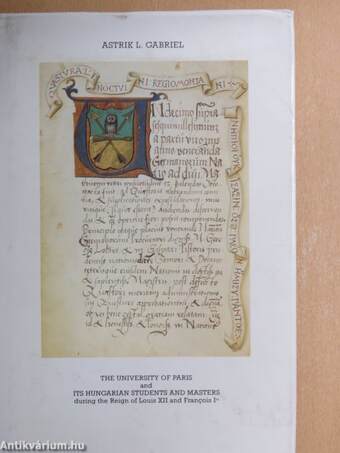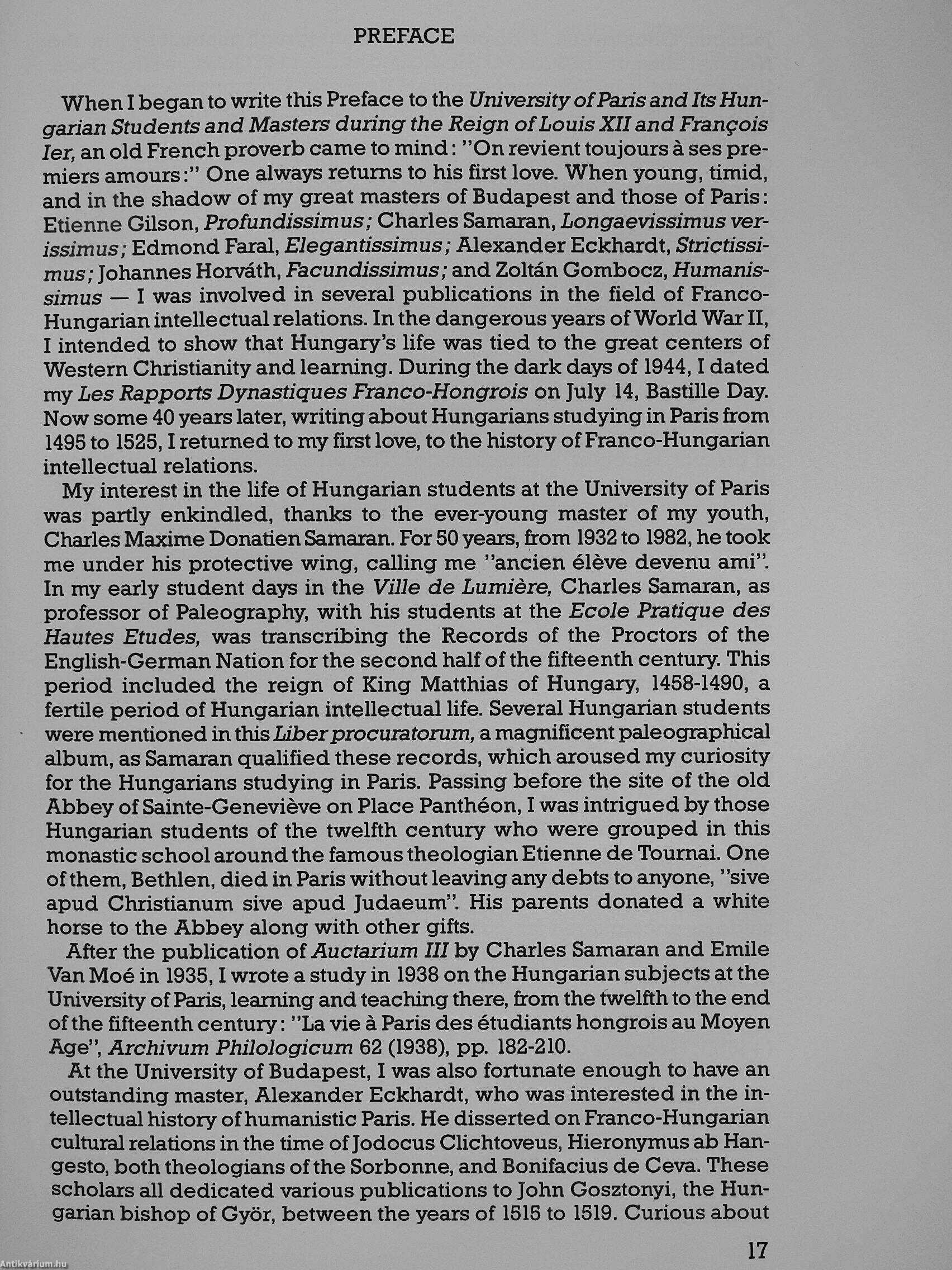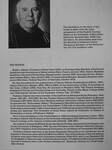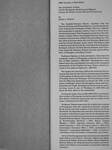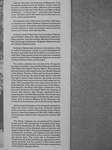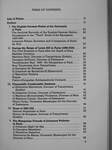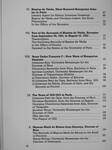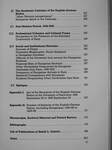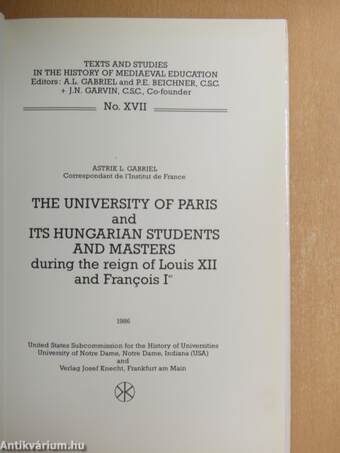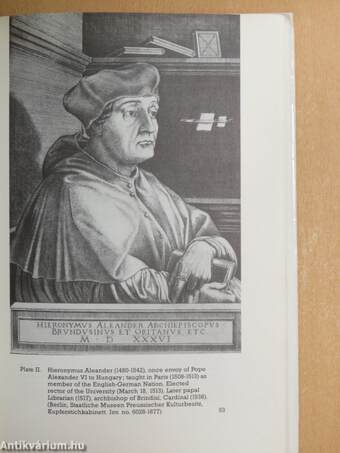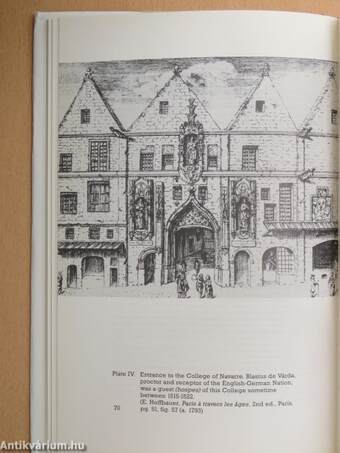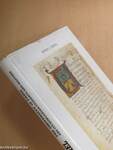1.063.472
kiadvánnyal nyújtjuk Magyarország legnagyobb antikvár könyv-kínálatát

VISSZA
A TETEJÉRE
JAVASLATOKÉszre-
vételek
The University of Paris and Its Hungarian Students and Masters during the reign of Louis XII and Francois Ier
| Kiadó: | Verlag Josef Knecht-United States Subcommission for the History of Universities-University of Notre Dame |
|---|---|
| Kiadás helye: | Frankfurt am Main-Notre Dame |
| Kiadás éve: | |
| Kötés típusa: | Fűzött keménykötés |
| Oldalszám: | 238 oldal |
| Sorozatcím: | Texts and Studies in the History of Mediaeval Education |
| Kötetszám: | 17 |
| Nyelv: | Angol |
| Méret: | 25 cm x 17 cm |
| ISBN: | 3-7820-0536-8 |
| Megjegyzés: | Fekete-fehér illusztrációkkal. |
naponta értesítjük a beérkező friss
kiadványokról
naponta értesítjük a beérkező friss
kiadványokról
Előszó
TovábbFülszöveg
The illustration on the front of this jacket is taken from the Liber receptoruin of the English-German Nation at the University of Paris (Paris, Sorbonne Archives Reg. 91(85) folio 120 verso). An illuminated page from the Records of Johannes Luscus Noctuinus, Receptor of the Nation for the 1511-1512 academic year.
THE AUTHOR
Astrik L. Gabriel, University of Notre Dame (1948-), is Corresponding Member ofthe French Académie des Inscriptions et Belles Lettres (Paris, France, elected 1962); Fellow, Medieval Academy of America (Cambridge, Massachusetts, elected 1966); Honorary Doctor, Ambro-siana Library (Milan, Italy, elected 1966) ; Corresponding Member, Bavarian Academy of Sciences (München, Federal Republic of Germany, elected 1972).
He was decorated by the governments of France, Palmes Académiques (Officer, 1950); Légion d'Honneur (Knight, 1966) ; Officer (1969) ; by the government of Italy, Commander of the Order of Merit (1969); Holy See, Pro Ecclesia et Pontífice (1976). The... Tovább
Fülszöveg
The illustration on the front of this jacket is taken from the Liber receptoruin of the English-German Nation at the University of Paris (Paris, Sorbonne Archives Reg. 91(85) folio 120 verso). An illuminated page from the Records of Johannes Luscus Noctuinus, Receptor of the Nation for the 1511-1512 academic year.
THE AUTHOR
Astrik L. Gabriel, University of Notre Dame (1948-), is Corresponding Member ofthe French Académie des Inscriptions et Belles Lettres (Paris, France, elected 1962); Fellow, Medieval Academy of America (Cambridge, Massachusetts, elected 1966); Honorary Doctor, Ambro-siana Library (Milan, Italy, elected 1966) ; Corresponding Member, Bavarian Academy of Sciences (München, Federal Republic of Germany, elected 1972).
He was decorated by the governments of France, Palmes Académiques (Officer, 1950); Légion d'Honneur (Knight, 1966) ; Officer (1969) ; by the government of Italy, Commander of the Order of Merit (1969); Holy See, Pro Ecclesia et Pontífice (1976). The French Academy awarded its Thorlet and Dourlans Prizes for his books. History of Ave Maria College (1956) and Chartularium Auctarii of the University of Paris, Tom. VI (1965).
Professor Gabriel was twice member of the Institute for Advanced Study (Princeton, New Jersey, 1950-1951 ; 1979-1980). He was Charles Chauncy Stillman Guest Professor at Harvard University (1963-1964). Head of the Medieval Institute, University of Notre Dame (1953-1974), he directed the "Ambrosiana, Milano" Photographic Microfilming Project for the University. He acquired and shipped to the United States 17,000 rolls of microfilm reproductions of Ambrosiana manuscripts, 2,500 colored slides and 12,000 glossy photos of illuminated manuscripts and drawings. The University of Notre Dame named its Collection on History of Universities in honor of Professor Gabriel.
Prior to his immigration to the United States in 1948 (naturalized American citizen, 1953), Professor Gabriel was Professorat the University of Budapest (I941-I947) and Director ofthe French College ofthe Canons of Prémontré (Gödöllő, 1938-1947).
He studied in France (Sorbonne, École des Hautes Etudes), promoted Doctor Summa cum Laude (University of Budapest, 1936). He was President of the Catholic Historical Association (1973), President of the International Commission for the History of Universities (1974-1985).
Professor Gabriel was bom in the Austro-Hungarian Monarchy in the old Roman city of Sopiane in Pannónia, later called Fünfkirchen (Pécs). One ofthe bishops of this city was the humanist poet Janus Pannonius Quinqueecclesiensis (1434-1472), who, in an Epístola (1.28) De Amygdala ín Pannónia nata, lauded the almond trees of Fünfkirchen-Pécs for being brave enough to blossom even in the wintery, freezing soil : Audaxper Gélidos en! Floret amygdala menses.
ISBN Number 3-7820-0536-8
Tíie University of Paris
and Its Hungarian Students and Masters
during the Reign of Louis XII and François 1er
by
Astrik L. Gabriel
The English-German Nation, together with the French, Norman and Picard Nations, constituted the Faculty of Arts at the University of Paris. The term "Nation" was employed to signify a tribe or clan to which an individual belonged. The Hungarian subjects ofthe University of Paris within the English-German Nation belonged to the province of High Germans (Altorum). The two other provinces were the Low German (Bassorum) and the Insular (English, Scots, Irish). The Nation itself united an international body of scholars from England, Scotland, Ireland, the Holy Roman Empire, Low Countries, Denmark, Sweden, Poland, Austria, and the Kingdom of Hungary, including Croatia.
Professor Gabriel, in this publication, describes the academic career of Hungarian subjects at the University of Paris between 1495-1525. Investigations were based upon the unpublished records of the receptors (treasurers) of the English-German Nation which survived in the Liber receptorum, 1495-1531.
The reason for choosing 152S as the terminal chronological date was the fact that for several years thereafter no Hungarian students came to Paris, due to the invasion of Turkish forces into Hungary. The flourishing contact with the West was destroyed on August 29, 1526, on the plains of Mohács where the Hungarian army was annihilated by the Turks. Archbishop Tomori and the youthful king, Louis II, son of Wladislas II (1490-1516) and Anne de Foix, died on the battlefield.
During the reign of Louis XII (1498-1515), a considerable number of Hungarian students came to Paris, an influx which continued during the first ten years of the reign of François 1er (1515-1347).
Professor Gabriel examines the intellectual contacts of Hungarians with the outstanding German, English, Scots, Dutch and Irish masters of the Nation and of the University. He describes the activities of those proctors, receptors, reformators under whom the Hungarian subjects were promoted and functioned as members ofthe English-German Nation. They met such leading printers as Berchtholdus Rembolt (¦hl518); Petrus Cesaris Wagner (+1509); logicians Johannes Mair (+1550); David Cranston (+1612); Georgius Lokert (+1647); and theologians Genrasius Wain (+1554), ambassador of François I" ; Leonardus Marstaller ( +1546), a column of orthodoxy of the University of Ingolstadt, and others.
Some of the Hungarians were elected and trusted with high offices ofthe Nation; Proctors: Blasius de Várda, Johannes de Nárda, Fianciscus Adam, Marcus Mark de Kémes. Blasius de Várda served as receptor and reformátor of the Nation and carried out extensive editorial activities.
Gabriel discusses the financial background of the Hungarian students from the richest—mostly from the diocese of Fünfkirchen-Pécs (Martinus Bomemissza, brother of the treasurer of the King, and Marcus Mark de Kémes) — to the poorest — generally from Transylvania. The latter had to take oaths stating they had no income ; juiavit paupertatem.
Not satisfied with outlining the activities of Hungarian subjects only in Paris, Professor Gabriel furnishes previously unknown information about the immatriculation of these subjects to other universities, such as Cracow, Padua and Vienna, after leaving Paris.
Students came to Paris from the dioceses of Transylvania (Erdély); Alba-Julia; Eger (Agriensis); Esztergom (Strigoniensis); Gyor Qauriensis); Kalocsa (Colocensis); Pécs (Quinqueecclesiensis); Veszprém (Vespiimiensis); and Zagreb (Zagrabiensis).
Professor Gabriel calls attention to the election ofthe so-called messengers, envoys oi nuntii designated for Hungary, and authorized by the Nation to conduct business there. They carried money from parents to students, communicated with ecclesiastical superiors, promoted contacts between Paris and Hungary.
The author analyzes the minutes of the Hungarian proctors, recorded in the unedited Libeiprocuratonim (1521-1552) ofthe English-German Nation. They reported various business discussed during the official meetings of the Nation, Faculty of Arts and the General Assembly of the University. As head of their Nation, they had the right to attend these sessions. Hungarian proctors ofthe Nation were conscientious of their religious heritage. They inscribed their own native saints into the official Calendar ofthe Liber pergamineus ofthe Nation: Saint Stephen, first King of Hungary; celebration ofthe discovery (Inventio) of his Right Hand; the memory of his son, Saint Emeric; Saint Gerard, martyred by Hungarian pagans; the brave King Ladislas. Their feasts were added to those saints already venerated by other nationalities, such as Carolus Magnus by the Germans, Ola-vus by the Scandinavians, and Ludmilla by the Czechs.
tJsing casual information of the receptors inserted between the lines of their accounts. Professor Gabriel gives a summary outline ofthe political events, historical facts, calamities (plagues of 1501/1502,1522) to which the Hungarian subjects were exposed during their stay in Paris.
The fifteen chapters are accompanied by Appendices I and II. The first lists the 37 receptors who functioned from September 20, 1494, to September 20,1525, with indication of their dioceses, dates of election, and length of stay in office. The second displays the number of bachelors, licentiati, and masters promoted during this period with denotation of the number of Hungarians among them. The entire text is illustrated with 15 plates showing the handwritings, signatures of Hungarian proctors, and the portraits of Pannonian saints whose feasts were inscribed into the Liberpergamineus of the English-German Nation. Vissza
Témakörök
- Életrajz > Gyűjtemények
- Idegennyelv > Idegennyelvű könyvek > Angol > Művelődéstörténet
- Idegennyelv > Idegennyelvű könyvek > Angol > Vallás > Kereszténység
- Idegennyelv > Idegennyelvű könyvek > Angol > Helytörténet
- Idegennyelv > Idegennyelvű könyvek > Angol > Pedagógia
- Idegennyelv > Idegennyelvű könyvek > Angol > Életrajz > Gyűjtemények
- Idegennyelv > Idegennyelvű könyvek > Angol > Történelem > Európa története > Magyarország története
- Idegennyelv > Idegennyelvű könyvek > Angol > Történelem > Európa története > Egyéb
- Művelődéstörténet > Kultúra > Története
- Művelődéstörténet > Intézményei > Iskolák
- Pedagógia > Intézmények > Oktatási intézmények > Felsőoktatás > Egyetem
- Helytörténet > Helyismeret > Intézmények
- Vallás > Kereszténység > Története
- Vallás > Kereszténység > Magyarországon > Tanulmányok
- Történelem > Életrajz > Egyéb
- Történelem > Levelek, forráskiadványok, dokumentumok > Középkor
- Életrajz > Tudomány > Egyéb
- Idegennyelv > Idegennyelvű könyvek > Angol > Életrajz > Tudomány
- Történelem > Magyarország története és személyiségei > Vegyesházi királyok (1308-1526) > Egyéb



